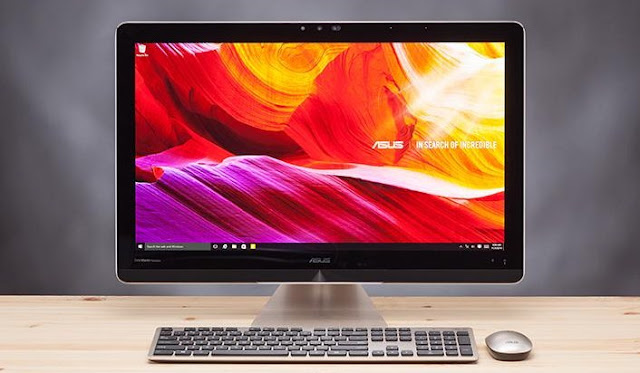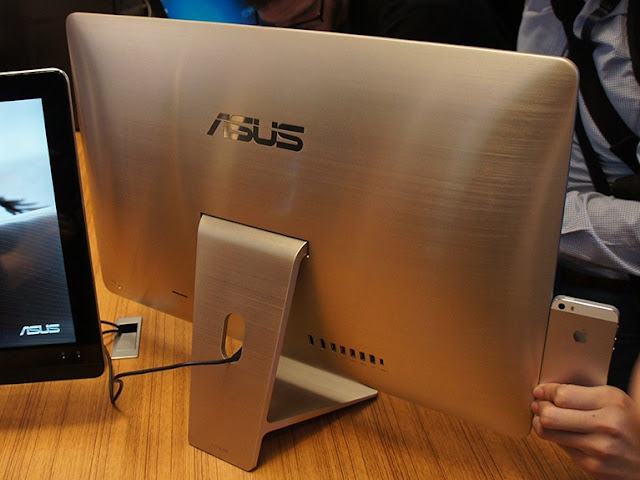Since you presumably officially possess a cell phone and a laptop, and perhaps a tablet, is there still space for a work area in your life? Maybe, in case you're a devoted PC gamer. Be that as it may, the normal American office laborer most likely wouldn't like to return home from a taxing day of sitting at a work area to, well, sit at a work area. So buyer level work areas have changed into computerized announcement sheets, across the board PCs that can sit in the kitchen and let you video talk with grandmother, locate a chicken parmesan formula, watch video clasps, or play some music. Purchasing an Apple iMac, the best known all in one, will cost you, yet there are a modest bunch of competent Windows options that look to repeat the iMac encounter however much as could reasonably be expected for under $1,000, including the Asus Zen AiO ($999). Be set up to trade off on figuring ability, be that as it may: This framework is fine for a kitchen PC, yet control clients will need to spend more for the Editors' Choice 21.5 inch iMac.
Smooth Design
The plan is emphatically iMac-like, however the dark, smooth bezel that encompasses the show is much smaller than the one on Apple's AIO, particularly at the base. It's defaced just by an Asus logo at the base focus and a fairly recoil commendable "SonicMaster Premium" moniker at the base right. It should show the ability of the AiO's speakers, however it's an odd thing to feature since the two stereo speakers conveying an aggregate of six watts of sound are not really anything to get energized over. They're sufficiently noisy for playing recordings or music in an expansive room, however they're no place close as prominent as the inconceivable speaker exhibit on the Dell XPS 27 across the board, which sounds superior to many home theater setups.
The show itself is a LED board with in-plane exchanging (IPS) innovation, which implies that the hues and differentiation don't wash out when you see it from a point. It's a touch screen, which is maybe its mark leverage over the non-touch iMac. An across the board introduced in a focal area in your home just asks to be touched, since relatives will probably utilize it for fast undertakings like delaying music or swiping through a photograph collection. The full HD (1,920 by 1,080) determination, in any case, comes up short. It by one means or another seems grainier than PC screens with identical resolutions, and is positively second rate compared to the flawless Retina show on the iMac. The graininess issue is similar to what we've encountered while utilizing the Acer Aspire Z3 on the off chance that you look carefully, you'll see the individual square pixels, which influences content to look barbed and pictures less splendid.
Standard Port Complement
The keyboard and mouse that accompany the Zen AiO are essential remote models, which interface utilizing a small beneficiary that you connect to one of the USB 2.0 ports at the back of the unit. They're fine when there's no other option as a reinforcement input technique for undertakings that can't be expert with the touch screen. The mouse is able to use both hands yet on the little side, and it's not etched to fit your hand. The keyboard's chiclet style keys are satisfyingly steady, yet the board itself is unstable and you can hear it shake as you compose. On the off chance that you intend to utilize the AiO for longer composing sessions, you'll surely need to put resources into a higher quality keyboard.
With the beneficiary for the keyboard and mouse taking up one of the USB ports, that abandons one more USB 2.0 port and a sum of four speedier USB 3.1 ports accessible. It's a moderately standard supplement for an across the board, in spite of the fact that USB-C ports now standard on most workstations and work areas are prominently truant, as they are on the Asire Z3. The iMac's prevalent I/O supplement incorporates two USB-C ports and four USB 3.0 ports, and despite the fact that it does not have the two USB 2.0 connectors, its keyboard and mouse associate by means of Bluetooth, so there's no dongle to take up an additional port.
Read other : Apple iMac 21.5-Inch With 4K Retina Display (2017)
The AiO likewise includes a HDMI-out port for interfacing with an outside screen (which you most likely won't have to do), a gigabit Ethernet jack, a solitary sound out jack, a Kensington-style bolt space, a power catch, and a SD card peruser. They're all effortlessly available at the back of the PC, and keeping in mind that the power catch and Ethernet port are to some degree covered up by the stand, they're no place close as difficult to reach as the ones on the XPS 27. Estimating 18.9 by 25.6 by 2.4 inches (HWD), the unit is generally light it just measures 16 pounds, contrasted and the 38 pound XPS 27 and the stand configuration makes it genuinely simple to pivot the AiO to get to the ports on the off chance that you have to connect a remark. The stand offers genuinely restricted tilt alternatives, in any case, which implies you'll need to introduce it on a hoisted surface so you're not touching your button to your neck to take a gander at the screen. I favor the XPS 27's stand, which underpins a totally even introduction that gives you a chance to cooperate with the PC as though it were an expansive tablet lying on a table.
Sufficient for Skype and Streaming Video
A standout amongst the most proper errands for a kitchen PC is video conferencing, regardless of whether by means of Skype, Facebook Messenger, or another stage. The Zen AiO's forward looking camera and inherent mouthpiece is satisfactory for easygoing video sessions, in spite of the fact that you'll need to skip taking still photographs with its measly 1 megapixel sensor. If that wasn't already enough, there are infrared sensors with the goal that you can sign in to your PC utilizing Windows Hello Face Sign-In. That is a clever element for a PC shared among relatives, since you can prepare Windows Hello to perceive an alternate face for every client account.
Remote association choices incorporate 802.11ac Wi-Fi and Bluetooth 4.1, and Asus underpins the framework with a one year guarantee that incorporates return shipping. On the off chance that you have to send your AiO in for benefit, you'll need to pay for outbound delivery yourself, which is a significantly more expensive recommendation than sending a workstation.
Midrange Processor
Asus offers a couple of various Zen AiO forms, however they're not configurable, you must be happy with the parts that Asus pre-introduces. My design of the Zen AiO is distinctly midrange, as its cost proposes. In my testing, the Intel Core i5-7200 CPU running at 2.5GHz and the 8GB of memory helped recordings stream easily and pages stack rapidly, which is the main part of what you'll likely utilize this AIO for. Similarly, the capacity setup a 128GB SSD and a 1TB HDD brings about fast startup times while as yet giving sufficient space to your photographs and recordings. It's a vastly improved setup than the single 2TB hard drive in the Aspire Z3, which takes an unending length of time to boot up since it does not have a SSD.
Affirmation of the AiO's reasonableness for ordinary registering undertakings comes as its outcome on our PCMark 8 benchmark test (3,124), which measures web perusing, video conferencing, word handling, and numerous different exercises that PC clients are probably going to do each day. Anything higher than 3,000 on this test demonstrates smart execution, despite the fact that the Aspire Z3 scored somewhat higher (3,341) because of its Core i7, and workstation-class PCs regularly score a couple of hundred focuses higher.
Tragically, you could be disillusioned in the event that you intend to utilize the Zen AiO for something besides mixed media utilization or web perusing. The Aspire Z3 can alter photographs and video significantly speedier, completing our accumulation of Photoshop picture control errands in 3 minutes and 3 seconds, about a moment faster than the Zen AiO. In like manner, the AiO was slower at finishing our Handbrake video-altering assignment (2:14) than both the Aspire Z3 (1:08) and the iMac (1:04). In any case, the AiO was snappier at both of these assignments than the Lenovo ThinkCentre X1, a business-arranged across the board with a more established 6th era Intel Core i5.
Without a discrete designs card, the AiO is likewise unsatisfactory for playing illustrations concentrated amusements, despite the fact that in any event it's following some great people's example. None of the practically identical holding nothing back ones could produce satisfactory edge rates on our Heaven and Valley computer game reenactments at full resoulution and most extreme quality settings. Indeed, even the iMac, with its predominant AMD Radeon Pro 560 illustrations card, neglected to break the 30fps edge that is regularly viewed as the base for pleasant gameplay. In the event that you intend to utilize your across the board as a gaming rig, you'll need to essentially build your financial plan to buy a framework with an all the more effective GPU.
Ready for Your Kitchen
A midrange all-in-one like the Asus Zen AiO can be a useful addition to a busy household, even if every member of it also uses a smartphone. It's better than an iMac in one very significant way: It has a touch screen, which makes it ideally suited to kitchen computing. Still, if you're willing to stretch your budget by a few hundred dollars to buy an one of Apple's AIOs, you'll be rewarded with an immensely higher quality (if slightly smaller) 4K display, along with more computing power and a better selection of ports. Depending on how you and your family plan to use your new all-in-one, those advantages may outweigh the Apple's lack of a touch screen.
Read other : LG gram 14 (2017)




Thank you for visiting. Please leave a comment or request the computer or laptop you want to review. ConversionConversion EmoticonEmoticon